CEP – KAS: Sahel Monitoring August 2023

This report focuses on operations throughout the Sahel in August 2023, which were claimed by al-Qaeda and ISIS propaganda outlets. In total, 57 different operations were claimed by these groups.
One of the most important events in August was the official announcement of the death of the previous Islamic State Caliph, Abu al-Husayn al-Husayni al-Qurashi, who led the group’s so-called caliphate for a mere 150 days. His successor, Abu Hafs al-Hashimi al-Qurashi, was announced to have taken over in an audio message spread by al-Furqan, the Islamic State’s central media apparatus, on August 3.

Quickly after the dissemination of the announcement, on August 5, the round of pledges of allegiance (bay’a) from ISIS cells and “provinces” began. Notably, after photos of fighters pledging bay’a was sent from ISIS-core in Iraq, the Islamic State in Western Africa Province (ISWAP) swiftly followed. While images from Iraq showed only a few small cells, the first pictures of a bay’a ceremony from ISWAP showed an impressive display of power. ISWAP showcased dozens of men, all well-armed and wearing military fatigues, to give the impression that ISWAP runs a professional army.
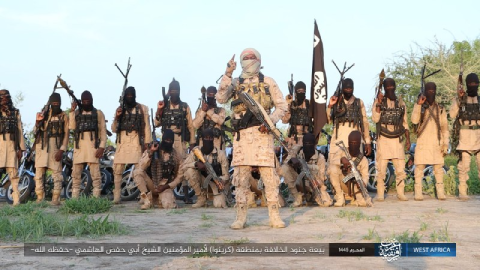
The ISWAP bay’a was followed on August 8 by a first one of the Islamic State in the Greater Sahel (ISGS). It is this picture set that provides an insight into the true power of the Islamic State in the Sahel. Hundreds of fighters were shown. Although these individuals did not wear uniforms, they were featured on motorcycles in pairs. The image conveys that ISGS commands a large number of rapid intervention units, consisting out of loosely coordinated cells.
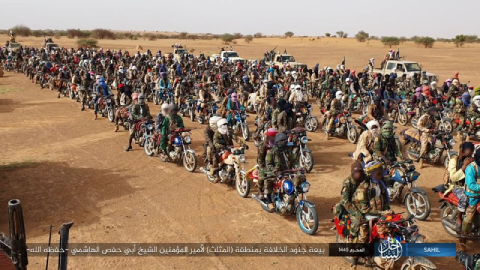
On August 9, ISWAP issued a second bay’a pledge. The pictures again showed well-armed and uniformed men, looking far more professional than the fighters that ISGS chose to display in its propaganda.
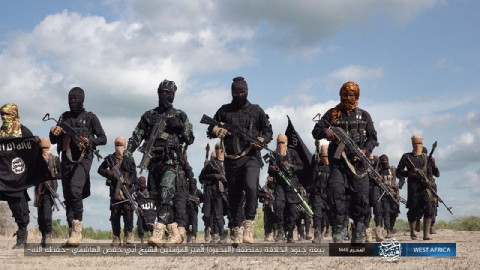
The same day, ISGS also published another photoset, which displayed several dozens of fighters. They do not appear as structured and organized as ISWAP, but once again, ISGS aimed to demonstrate that it commands a large number of forces.
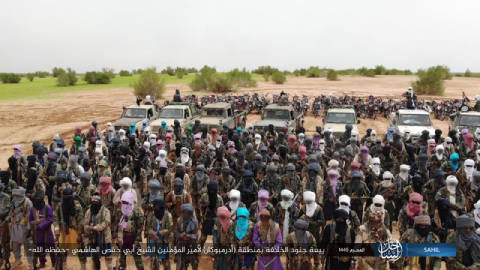
On August 9, a third set of photos was distributed by ISWAP, where heavily armed individuals dressed in military uniforms swore bay’a.
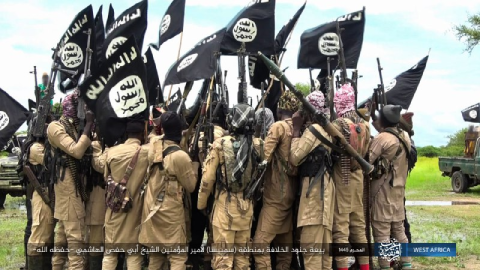
On August 10, the Sahel Province ISGS responded again. As usual in the previous style of reporting.
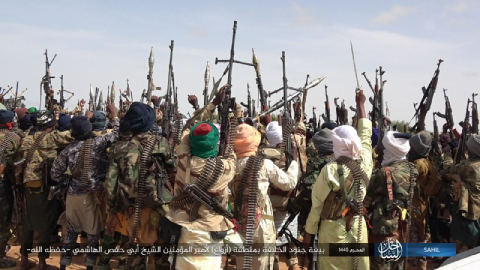
August 10 also witnessed another bay’a from the Sahel, again a picture set from ISWAP, this time showing two different cells.
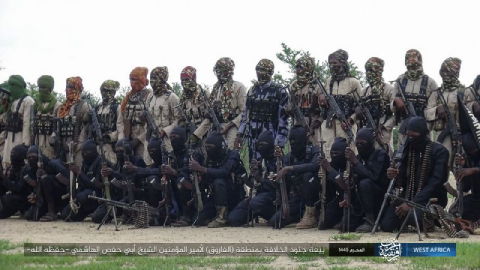
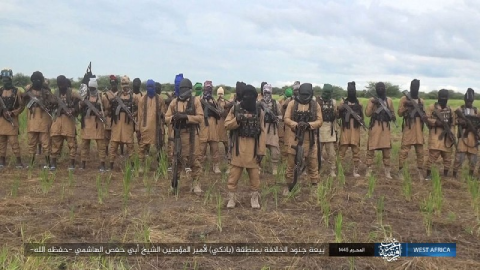
August 15 marked the last bay’a round from the Sahel by ISGS.
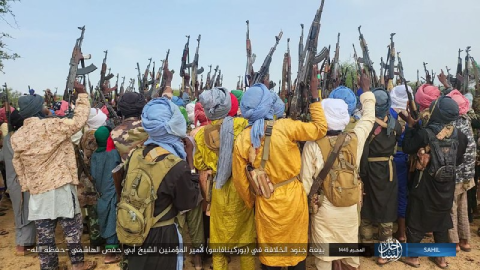
It is not coincidental that the majority of the bay’a pictures come from the Islamic State’s African provinces. In addition to the propaganda output from ISWAP and ISGS, there were bay’a messages from Somalia, Central-Africa, and Mozambique (though, interestingly not from Libya or Sinai). The message the Islamic State is propagating is clear: Africa is the new epicenter of their fight.
Attacks in the Sahel: General Trend
As expected, the number of claimed attacks, both from the Islamic State’s affiliates as well as from al-Qaeda in the region are on the rise again. This trend, first identified in June 2023, seems to be continuing, and it is likely that the number of monthly claimed attacks in the region will reach over 100 by early 2024. Given the systematic underreporting of attacks by these groups, this will mean a devastating level of violence and instability in the region.
The impact of the recent coup in Niger, the French withdrawal from Mali and Burkina Faso, the beginning withdrawal of French forces from Niger, as well as the winding down of the operations of the United Nations Multidimensional Integrated Stabilization Mission in Mali (MINUSMA) are already clearly showing in the rising number of claimed attacks. In August 2023, the number of claimed attacks in Mali and Niger were the highest since CEP reporting started in December 2022.
In August, Mali suffered increased activity from both ISGS and Jama’a Nusrat ul-Islam wa al-Muslimin’ (JNIM). Both groups focus on the same targets: the Malian military regime, militias, and the Wagner Group. In fact, the Russian mercenaries have never played such a prominent role before in the propaganda of these terror groups from the Sahel.
Intense fighting between ISGS and JNIM continued in August. For example, ISGS claimed to have killed and wounded around 40 JNIM fighters in just one attack. In total, an-Naba’ reported three clashes with JNIM. ISGS also targeted the Wagner Group in one attack near Menaka. JNIM attacked the Malian army and the Wagner Group on at least four occasions in the area of Timbuktu. It seems that the battle for control of central Mali between ISGS and JNIM is fully developing. Generally, ISGS focuses on the eastern part of the country whereas JNIM is mostly active in the north and in the center, meaning the center of the country is the main area of competition between both groups. A brazen attack by JNIM on MINUSMA forces, wounding four blue helmet soldiers, was claimed to have been executed near Timbuktu. Furthermore, Niamey, Niger witnessed an attack on a presumed German aid worker by ISGS.
Another notable trend are the increasing attacks on Christians in Nigeria by ISWAP. At least 23 Christians were killed in raids by ISWAP, both in the North (Yobe) as in the South (Borno). ISGS meanwhile is becoming more and more engaged in implementing Islamic penal law (Hudud, Ta’zir and Qisas). Throughout Mali, ISGS meted out Hudud punishments in public on at least six different occasions. All of these events featured in the group’s propaganda output, sending a clear message to the local population as well as its wider circle of sympathizers. The harshest sentence (Hadd) was for Sariqa (theft), by amputating the alleged thief’s right hand.
One of the most important events this month was the public call for a general mobilization for the fight against the Malian army and the Wagner Group, published by JNIM on August 21. Since the publication of the statement, an increased number of attacks were claimed by JNIM, trying to portray that its call was successful.
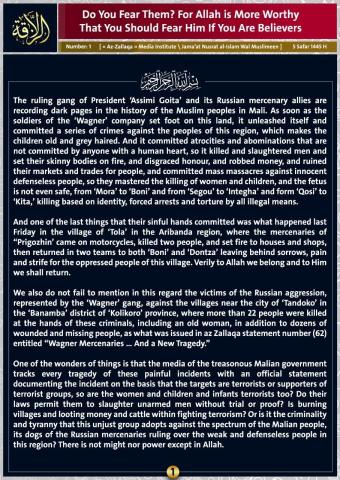
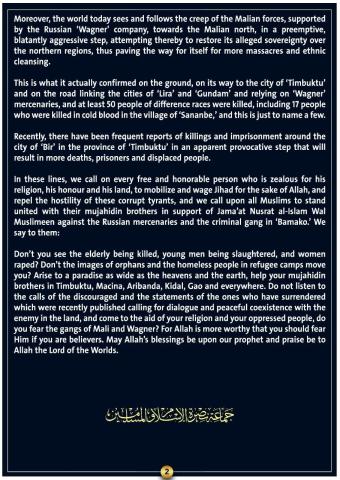
Table 1: Claimed Attacks (December 2022 – August 2023)
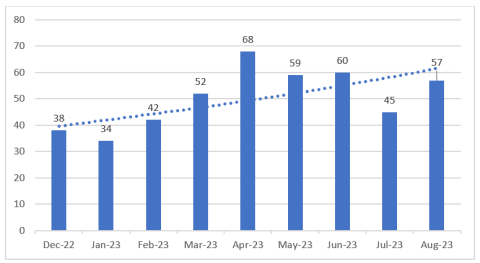
Table 2: Claimed Attacks per Group (December 2022 – August 2023)
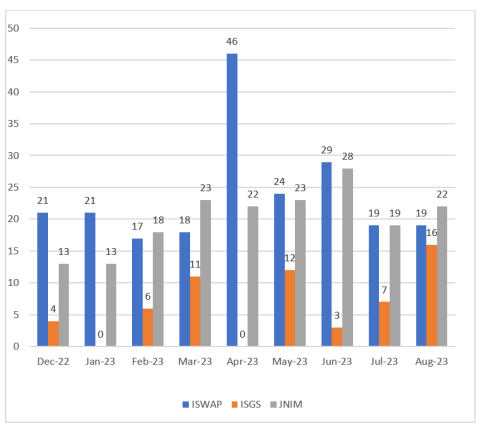
Table 3: Claimed Attacks per Country (December 2022 – August 2023)
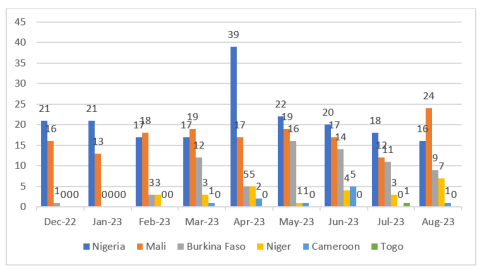
Attacks per Country
When CEP reporting began in December 2022, the terrorist insurgency in the Sahel was still rather limited. Some attacks occurred in Nigeria and Mali, and one single incident occurred in Burkina Faso. However, terrorist violence quickly spread. From February 2023 onwards, Niger was also affected by terrorist violence. Cameroon was first struck in March, and in July, Togo was hit. The overall impact of the terrorist insurgency in the region is growing by the month. Therefore, slowly the entire region is engulfed with terrorist violence. The withdrawal of French, other Western, and MINUSMA forces coupled with coups in Mali, Burkina Faso, and recently Niger are significantly exacerbating the situation. The resulting security vacuum is not filled by other forces—as Wagner is only playing a minor and mostly negative role in counterterrorism operations—but by the terrorist groups.
Map 1: Armed Violence Involving Jihadist Groups
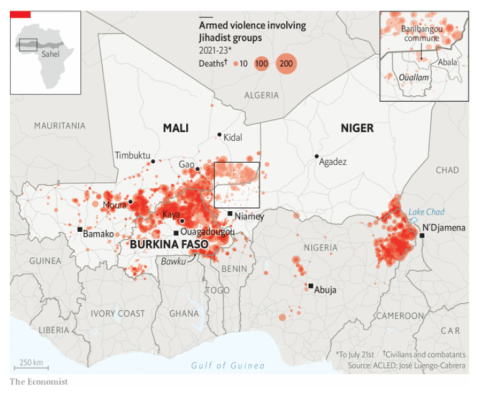
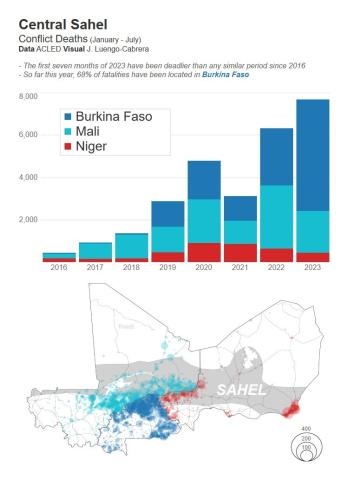
Source : https ://twitter.com/J_LuengoCabrera/status/1686365881343856640?s=20
- Mali. For the first time, the attacks in Mali surpass the number of claimed attacks in all other countries of the region. A total of 24 attacks were claimed in August. It is important to take into account that ISGS is likely underreporting. Therefore, the number of security incidents is likely higher. In August, infighting between JNIM and ISGS intensified. Increasingly, mercenaries of the Wagner Group are now regularly targeted. Other important events were the public call by JNIM for a general mobilization and a marked increase in propaganda messages by ISGS, demonstrating that it is implementing the harshest and most extremist interpretation of Islamic law in the areas that the group controls. Multiple propaganda reports were published focusing on the execution of Islamic penal law in the areas under the control of ISGS. As it recently announced in an-Naba’ they will continue the implementation of Islamic Law throughout the territories under control. This seems to demonstrate that ISGS feels sufficiently in control in these areas and no longer has to take potential hostility of the local population into account.
- Nigeria. In total, 17 attacks were committed in Nigeria, and all claimed by ISWAP. Most of the attacks by ISWAP were of low impact, with few casualties per attack. A worrying trend in Nigeria is the increasing number of attacks on Christian villages. At least 20 Christians and militia-members were killed in total. For example, in one attack on a village the local church and several houses were destroyed.
- Burkina Faso. Nine attacks were claimed by JNIM in Burkina Faso. Around 54 casualties were reported by az-Zallaqa Media.
- Niger. Following last month’s coup in Niger, all groups in the region seem to see this situation as an opportunity and extended their operations in the country. In total, around 35 casualties were claimed in seven different incidents. The most impactful attack was claimed by JNIM. On August 17, JNIM fighters attacked the Nigerien army near Boni, killing 17 soldiers.
- Cameroon. One attack was claimed in Cameroon. On August 20, ISWAP fighters killed and wounded eight Cameroonian soldiers in Marwa.
Table 4: Total Number of Claims
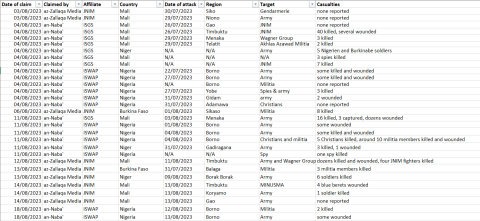
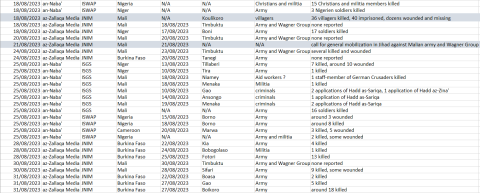
Attacks per Affiliate
JNIM
Az-Zallaqa Media published a total of 24 messages in August. Two statements stand out. The first published on August 18 strongly condemned an attack by the Wagner Group in the area of Koulikoro, Mali. Wagner Forces allegedly killed around 40 villagers and arrested a few dozen people. Dozens more were claimed missing or wounded in the attack. In response to this and several previous heinous attacks by the Russian mercenary group, JNIM published a general call for mobilization in Mali on August 21. It remains to be seen whether this general call for mobilization will cause any significant effects on the level of violence by JNIM fighters in the coming weeks and months.
Table 5: Number of Attacks by JNIM
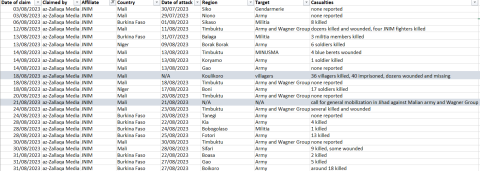
ISWAP
Nineteen attacks were claimed by ISWAP, with 16 in the heartland of Nigeria, two in Niger, and one in Cameroon. Nearly all attacks were of relatively low impact with only a few casulaties per attack. As noted above, a worrying trend are increasing attacks on the Christian population of Nigeria.
Table 6: Number of Attacks by ISWAP

ISGS
ISGS posted only 16 claims concerning attacks of its fighters in August. However, as noted in previous reports, ISGS seems to be generally underreporting its operations. In August, JNIM was hit hard by its terrorist competitor, ISGS claimed to have killed at least 47 JNIM members. An-Naba’ also published a lengthy article on the application of Islamic Penal Law in the areas under control. At least five people had their right hand amputated for theft and one person was stoned to death for adultery.
Table 7: Number of Attacks by ISGS

Conclusion
The number of terrorist attacks in the region is rising again. This confirms the trend of the last few months. JNIM is increasing its activities, not only military but also attempting to portray itself as the “defender” of the local population. The fact that the group openly condemned the brutal attacks by the army and the Wagner Group and issued a call for general mobilization in Mali is telling. All of these actions are part of its strategy of winning hearts and minds and build further local support.
As we have seen about a decade ago in Syria and Iraq, ISIS is following a different strategy. Once the group is sufficiently entrenched in an area it immediately begins imposing the most extremist implementation of Islamic law. ISIS strategy is rule through fear among the local population rather than compassion. Therefore, the emphasis of ISGS propaganda of public punishments in August indicates that the terror group feels sufficiently in control and entrenched in the areas it controls and no longer fears popular discontent to its harsh rule.
Overall the situation continuous to deteriorate. Further withdrawals of Western and multinational forces following the recent coup in Niger will accelerate this negative trend. The potential increased presence of Russian mercenaries in the region will not fill the security vacuum resulting from these withdrawals. This vacuum presents an opportunity for the terrorist groups in the region, which they are eagerly exploiting.
Stay up to date on our latest news.
Get the latest news on extremism and counter-extremism delivered to your inbox.